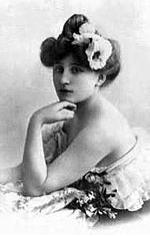Sidonie-Gabrielle Colette (Novelist)
 Colette was the surname of the French novelist Sidonie-Gabrielle Colette (28 January 1873 – 3 August 1954).
Colette was the surname of the French novelist Sidonie-Gabrielle Colette (28 January 1873 – 3 August 1954).
She is best known for her novel Gigi (upon which the stage and film musical comedies by Lerner & Loewe, of the same title, were based).
Colette was born in Saint-Sauveur-en-Puisaye, Yonne, in the Burgundy Region of France, the daughter of Jules-Joseph Colette and Adèle Eugénie Sidonie Landoy ("Sido").
In 1893 she married Henri Gauthier-Villars, a famous bisexual wit known as "Willy", who was 15 years her senior.
Her first books, the Claudine series, were published under the pen name of her husband, "Willy", writer, music critic, "literary charlatan and degenerate". Claudine still has the power to charm; in belle epoque France it was downright shocking, much to Willy's satisfaction and profit.
In 1906 she left the unfaithful Gauthier-Villars, living for a time at the home of the American writer and salonist Natalie Barney. The two had a short affair, and remained friends until Colette's death.
She was also, according to author Jean-Claude Baker’s book Josephine: The Hungry Heart, involved for some time with actress Josephine Baker.
Colette took up work in the music halls of Paris, under the wing of Mathilde de Morny, the Marquise de Belbeuf, known as Missy, with whom she became romantically involved. In 1907, the two performed together in a pantomime entitled Rêve d'Égypte at the Moulin Rouge. Their onstage kiss nearly caused a riot, which the police were called in to suppress.
As a result of this scandal, further performances of Rêve d'Égypte were banned and Colette and de Morny were no longer able to openly live together, though their relationship continued a total of five years. She also was involved in a heterosexual relationship during this time, with the Italian writer Gabriele D'Annunzio. Another affair during this period was with the automobile-empire scion, Auguste Herriot.
In 1912, Colette married Henri de Jouvenel, the editor of the newspaper Le Matin. The couple had one daughter, Colette de Jouvenel, known to the family as Bel-Gazou. Colette de Jouvenel later stated that her mother did not want a child and left her in the care of an English nanny, only rarely coming to visit her.
In 1914, during World War I, Colette was approached to write a ballet for the Opéra de Paris which she outlined under the title "Divertissements pour ma fille". After Colette herself chose Maurice Ravel to write the music, he reimagined the work as an opera, to which Colette agreed. Ravel received the libretto to L'Enfant et les sortilèges in 1918, and it was first performed on 21 March 1925.
During the war, she converted her husband's St. Malo estate into a hospital for the wounded, and was made a Chevalier of the Legion of Honour (1920). She divorced Henri de Jouvenel in 1924 after a much talked-about affair with her stepson, Bertrand de Jouvenel.
In 1935, Colette married Maurice Goudeket, an uncle of Juliet Goudeket alias Jetta Goudal.[6] After 1935, her legal name was simply Sidonie Goudeket. Maurice Goudeket published a book about his wife, Close to Colette: An Intimate Portrait of a Woman of Genius. An English translation was published in 1957 by Farrar, Straus & Cudahy, New York.
Post-war, her writing career bloomed following the publication of Chéri (1920). Chéri tells a story of the end of a six-year affair between an aging retired courtesan, Léa, and a pampered young man, Chéri.
Turning stereotypes upside-down, it is Chéri who wears silk pajamas and Léa's pearls, and who is the object of gaze. And in the end Léa demonstrates all the survival skills which Colette associates with femininity. (The story continued in La Fin de Chéri (1926), which contrasts Léa's strength and Chéri's fragility and decline).
After Chéri, Colette entered the world of modern poetry and paintings revolving around Jean Cocteau, who was later her neighbor in Jardins du Palais-Royal. Their relationship and life is vividly depicted in their books. By 1927, she was frequently acclaimed as France's greatest woman writer.
"It ... has no plot, and yet tells of three lives all that should be known", wrote Janet Flanner of Sido on its publication in 1930. "Once again, and at greater length than usual, she has been hailed for her genius, humanities and perfect prose by those literary journals which years ago ... lifted nothing at all in her direction except the finger of scorn."
She published around 50 novels in total, many with autobiographical elements. Her themes can be roughly divided into idyllic natural tales or dark struggles in relationships and love. All her novels were marked by clever observation and dialogue with an intimate, explicit style. Her most popular novel, Gigi, was made into a Broadway play and a highly successful Hollywood motion picture, Gigi, starring Maurice Chevalier, Louis Jourdan and Leslie Caron.
A controversial figure throughout her life, Colette flaunted her lesbian affairs.
In the German occupation of France during World War II she aided her Jewish friends, including hiding her husband in her attic all through the war.
She was a member of the Belgian Royal Academy (1935), president of the Académie Goncourt (1949) (and the first woman to be admitted into it, in 1945), and a Chevalier (1920) and a Grand Officier (1953) of the Légion d'honneur.
When she died in Paris on 3 August 1954, she was the first woman given a state funeral in France, although she was refused Roman Catholic rites because of her divorces. Colette is interred in Père Lachaise Cemetery in Paris.
Singer-songwriter Rosanne Cash paid tribute to the writer in the song, "The Summer I Read Colette", on Cash's album 10 Song Demo.
Designer Marcela Calvet named one of her most sought-after luxury handbags, the "Colette", in honor to the writer.